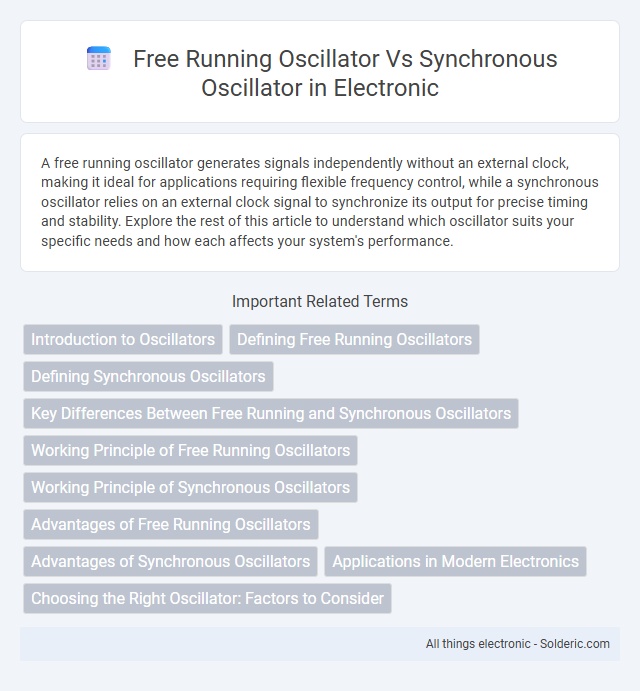A free running oscillator generates signals independently without an external clock, making it ideal for applications requiring flexible frequency control, while a synchronous oscillator relies on an external clock signal to synchronize its output for precise timing and stability. Explore the rest of this article to understand which oscillator suits your specific needs and how each affects your system's performance.
Comparison Table
| Aspect | Free Running Oscillator | Synchronous Oscillator |
|---|---|---|
| Definition | An oscillator operating independently without external synchronization. | An oscillator synchronized to an external clock or reference signal. |
| Frequency Stability | Lower stability; frequency may drift due to temperature and component variations. | High stability by locking frequency to an external reference. |
| Phase Noise | Higher phase noise because of unregulated oscillations. | Lower phase noise due to synchronization with the reference. |
| Applications | Simple clock generation, low-cost timing circuits. | Communication systems, phase-locked loops, precise timing devices. |
| Complexity | Simple design, fewer components. | More complex due to feedback and synchronization circuitry. |
| Frequency Range | Limited by internal components and design. | Broader range achievable through external reference control. |
Introduction to Oscillators
Free running oscillators generate a continuous periodic signal without requiring an external timing reference, making them ideal for applications needing flexible or independent frequency generation. Synchronous oscillators rely on an external clock or reference signal to maintain precise synchronization, ensuring stable and accurate frequency output for timing-sensitive systems. Your choice between these oscillators depends on the required stability, accuracy, and application context in electronic circuit design.
Defining Free Running Oscillators
Free running oscillators generate continuous wave signals without requiring an external timing reference, relying solely on their internal components to maintain oscillation frequency. These oscillators are characterized by their autonomous frequency stability, which can vary due to temperature changes and component tolerances. In contrast, synchronous oscillators depend on an external clock or synchronization signal to lock the output frequency precisely.
Defining Synchronous Oscillators
Synchronous oscillators maintain a fixed phase relationship with an external reference signal, ensuring precise timing and reduced phase noise compared to free running oscillators, which operate independently without synchronization. Your choice between these oscillators depends on the application requiring either stable frequency control or autonomous oscillation. Synchronous oscillators are essential in systems like communication networks and clock distribution where timing accuracy is critical.
Key Differences Between Free Running and Synchronous Oscillators
Free running oscillators generate signals independently based on their internal circuitry, resulting in frequency variations influenced by component tolerances and environmental changes. Synchronous oscillators rely on an external clock or reference signal, ensuring precise frequency control and reduced jitter, which is critical for applications requiring synchronization such as communication systems. Your choice between these oscillators impacts system stability, timing accuracy, and overall performance.
Working Principle of Free Running Oscillators
Free running oscillators operate based on the principle of generating a continuous output signal without requiring an external synchronization input, using feedback networks to sustain oscillations at a natural resonant frequency determined by circuit components like inductors and capacitors. They maintain oscillations by amplifying and feeding back a portion of the output signal into the input, ensuring the loop gain is exactly one and the phase shift is zero or a multiple of 360 degrees. This self-sustained oscillation contrasts with synchronous oscillators, which rely on an external clock to control oscillation timing.
Working Principle of Synchronous Oscillators
Synchronous oscillators operate by locking their output frequency and phase to an external reference signal, ensuring precise frequency stability and reduced phase noise. This is achieved through a feedback loop mechanism that continuously compares the oscillator's output with the reference, adjusting the oscillation to maintain synchronization. Unlike free running oscillators, which generate signals based solely on internal components, synchronous oscillators rely on external timing sources for enhanced accuracy.
Advantages of Free Running Oscillators
Free running oscillators offer the advantage of simpler circuit design and inherent frequency stability without requiring external synchronization signals, making them ideal for standalone applications. They provide rapid start-up times and reduced susceptibility to phase noise, enhancing signal purity in communication systems. Their independence from reference clocks allows greater flexibility in diverse operating environments and lower power consumption.
Advantages of Synchronous Oscillators
Synchronous oscillators offer precise frequency stability by locking onto an external reference signal, reducing phase noise and jitter significantly compared to free running oscillators. Their ability to maintain consistent timing enhances performance in applications such as communication systems, digital circuits, and signal processing. This synchronization ensures better signal integrity and improved system reliability under varying environmental conditions.
Applications in Modern Electronics
Free running oscillators are widely used in applications requiring stable clock generation without external synchronization, such as in microcontrollers, RF circuits, and simple timing devices. Synchronous oscillators, essential for digital communication systems and microprocessor timing, provide precise frequency control and reduce jitter by locking to an external reference signal. Modern electronics leverage synchronous oscillators in phase-locked loops (PLLs) for frequency synthesis, while free running oscillators serve in low-cost, low-complexity timing solutions.
Choosing the Right Oscillator: Factors to Consider
Choosing the right oscillator involves evaluating key factors such as frequency stability, power consumption, and noise performance. Free running oscillators offer simplicity and lower cost but may suffer from frequency drift over temperature and supply variations, making them less suitable for precision applications. Synchronous oscillators provide better frequency accuracy and phase noise characteristics by locking to an external reference, ideal for systems demanding tight synchronization and low jitter.
Free running oscillator vs Synchronous oscillator Infographic

 solderic.com
solderic.com